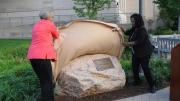Midway through the list of names was when the crowd fell fully silent. Some 300 people, suddenly pinned in place, stood motionless in a half-circle around the outdoor podium where Janet Halley, Royall professor of law, was reading out the names of slaves who’d once belonged to Isaac Royall Jr., the eighteenth-century sugar-plantation owner whose fortune endowed Halley’s professorship and helped establish Harvard Law School (HLS). “Hector, Ruth, Nan,” Halley read, “Peter, Fortune, Black Betty…George, Sarah, Jacob, Jemmy.” None of them more than first names, and some not even that, bearing no resemblance to the African names their holders would surely have answered to “directly and genuinely,” Halley said. “These were the names white record keepers thought were proper.”
Phoebe, Plato, Abraham. Betsy, Diana, Belinda. There were about 60 names in all, a shocking number, Halley noted, but still only a fraction of those whom the Royall family owned.
On Tuesday evening, HLS, formally founded in 1817, opened its bicentennial observance by unveiling a memorial plaque in the center of the Law School campus, just outside the Caspersen Student Center, honoring the Royall family slaves—those whom Halley named, along with the numberless others whose names have been lost. The monument leaves them all unnamed, however; as Halley explained, the existing records are incomplete and constitute the “encrustation” of a system that turned people into propery. Better to leave the anonymity, Halley and the other organizers decided. And so, attached to a large stone, the plaque reads, in part: “May we pursue the highest ideals of law and justice in their memory.” (Last year, President Drew Faust similarly dedicated a plaque on Wadsworth House to the four slaves who had lived and worked there.)
Eighteen months ago, following student protests and a faculty committee’s deliberations, the law school jettisoned its blue-and-crimson shield, adapted in the 1930s from the Royall family crest. This week HLS dean John F. Manning stood beside the newly unveiled memorial and declared, “Our school was founded with wealth generated though the profoundly immoral institution of slavery. We should not hide that fact nor hide from it.… To be true to our complicated history, we must also shine a light on what we are not proud of.”
Inside Wasserstein Hall earlier in the evening, listeners had heard some of that complicated history from Warren visiting professor of American legal history Daniel Coquillette. The author of On the Battlefield of Merit: Harvard Law School, the First Century, he spoke not only about Royall, a brutal slave owner whose plantation in Antigua was notorious (he kept a 500-acre farm in Medford, too), but also about the school’s connections to the Fugitive Slave Act of 1793—which most faculty members at the time strongly supported, Coquillette said, and which former dean and Supreme Court Justice Joseph Story was reluctantly instrumental in enforcing in 1842, when he sent back into slavery a woman who’d escaped to Pennsylvania and her two free-born children. Twelve years later, faculty member Edward Greeley Loring, a federal magistrate in Boston, ordered escaped slave Anthony Burns returned to Virginia under the 1850 Fugitive Slave Act, a decision that led to riots; Burns had been defended by Richard Henry Dana, A.B. 1837, LL.B. ’39, LL.D. ’66.
Coquillette described the fights that broke out among students and faculty in the 1850s, as the country lurched toward civil war. He talked about abolitionist Charles Sumner, A.B. 1830, LL.B. ’34, LL.D. ’59, who was famously beaten almost to death on the floor of the Senate in 1856 by an enraged South Carolina congressman. Before then, he had been an anti-slavery activist at HLS, at a time when they were “scarce on the ground” and the school drew about 35 percent of its student body from the Deep South. In fact, Coquillette added, “Harvard Law School was the most important source of leaders for the Confederacy, with the exception of West Point.” Some 260 students volunteered; another 360 volunteered with the Union. The fatality rate for each group was extraordinarily high, around 25 percent. “There’s been nothing like this at Harvard Law School before or after.” He called the Civil War “the most traumatic event in the history of the school.”
After Coquillette’s remarks—and a panel discussion that followed, with Halley, Warren professor of American legal history Annette Gordon-Reed, Klein professor of law Randall Kennedy, and Schipper professor of law Bruce Mann—audience members filed out into the courtyard to see the new memorial revealed. Speaking from the podium, Faust acknowledged, as she did a few months ago at a Radcliffe Institute conference on universities and slavery, that Harvard had been “directly complicit in America’s system of racial bondage.” Drawing a thread between that past and the nation’s current turmoil over whether to dismantle Confederate statues, she noted, “In recent weeks we have seen chilling instances of hatred, racism, and violence across the nation, most recently in Charlottesville, an American college town not very different from our own. This was another especially painful reminder of the continuing grip of the past, and the persisting legacies of slavery’s injustices, and cruelties.”
Gordon-Reed, who composed the words inscribed on the memorial plaque, said that HLS’s foundational tie to slavery “is really the American story,” and expressed a thought that had become a theme throughout the evening: the words on the plaque, she said, were intended to bring those enslaved by the Royall family “into our minds and our memories with the hope that it will spur us to try to bring to the world what was not given to them: the law’s protection and regard and justice.”
Follow Lydialyle Gibson @lydialyl.









